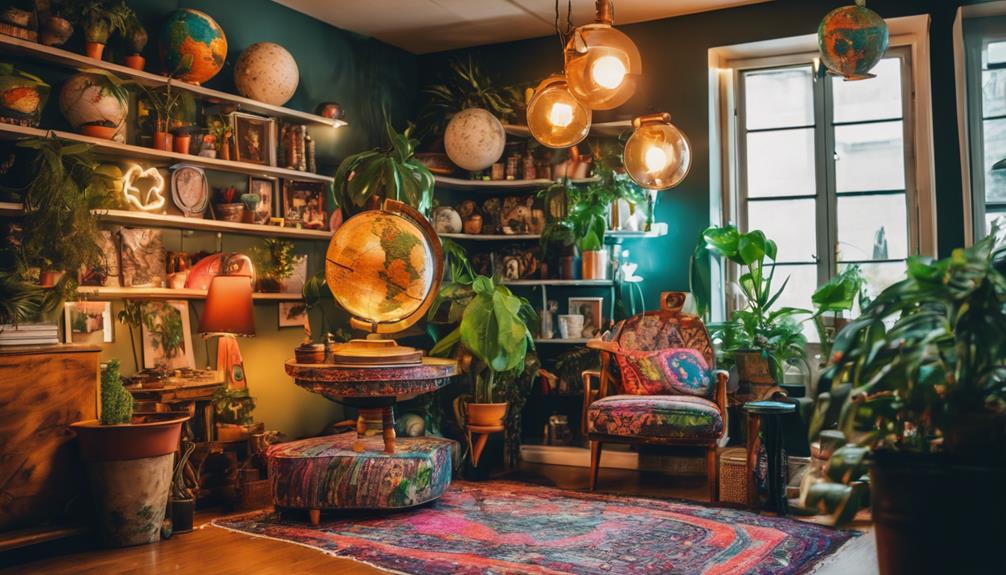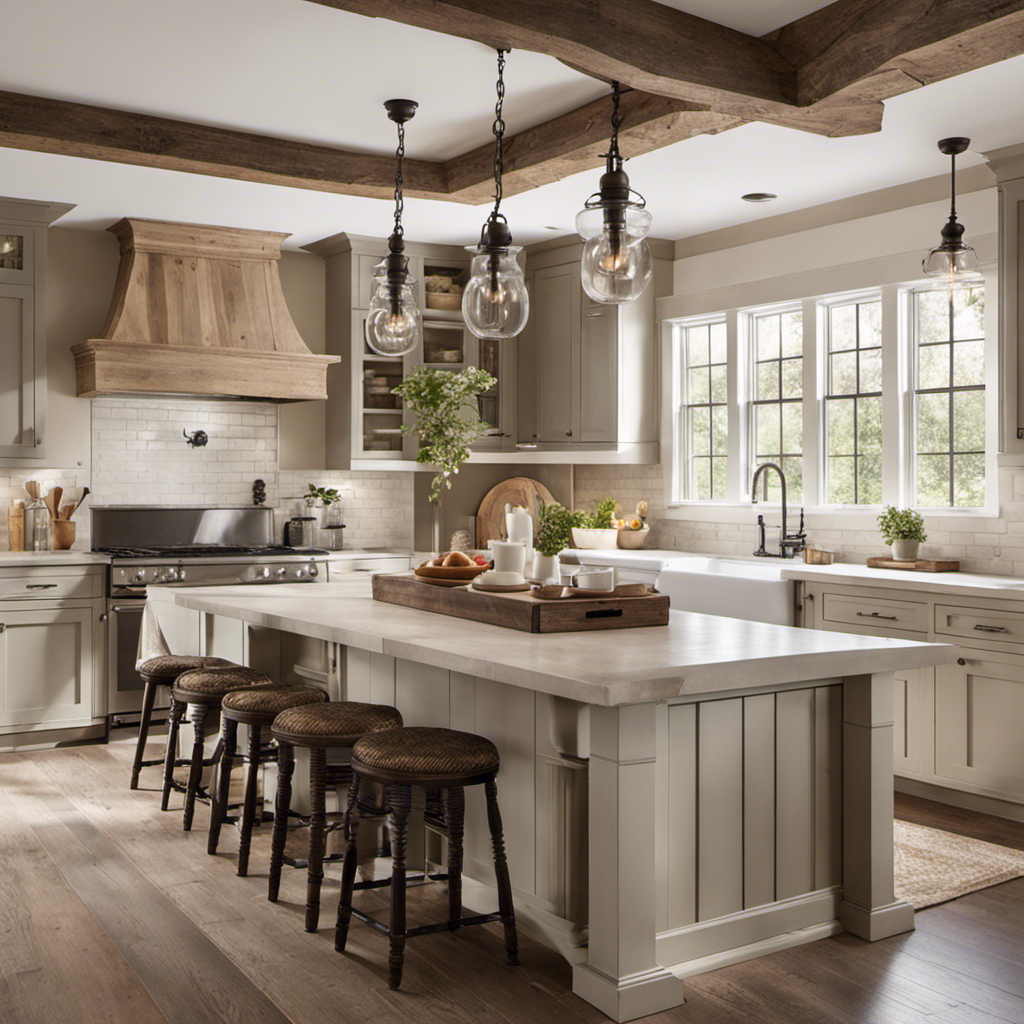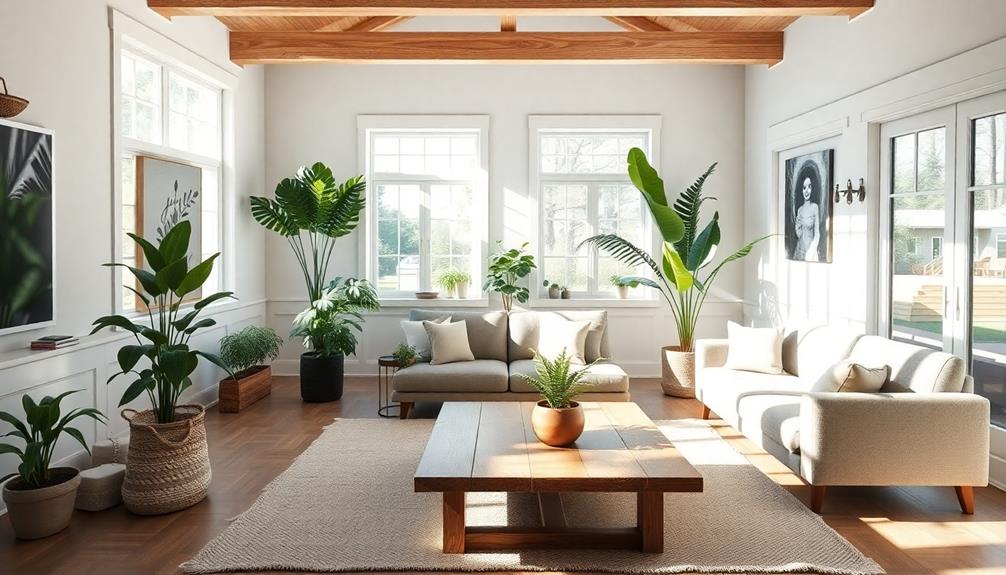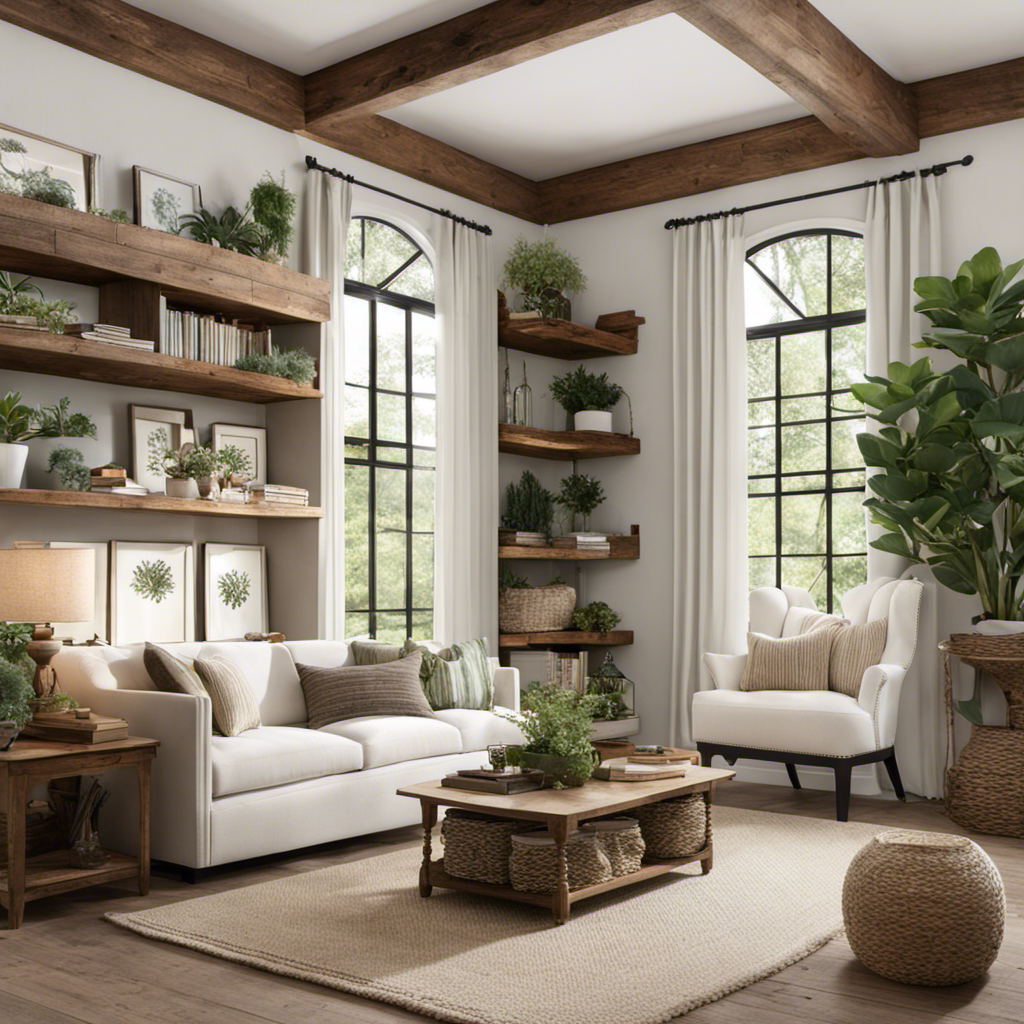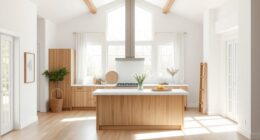Perfect lighting can completely transform your space, shaping the atmosphere and impacting your mood in ways you might not believe. Start by layering three types of lighting: ambient for overall brightness, task for specific activities, and accent to highlight unique features. Use warm tones for relaxation and brighter lights for energy. Dimmers give you control over intensity, allowing you to switch up the vibe as needed. Strategic placement of light fixtures can enhance both functionality and beauty, creating a cozy sanctuary or a vibrant workspace. By exploring these techniques, you'll discover even more ways to elevate your space.
Key Takeaways
- Proper lighting transforms a room's atmosphere, significantly influencing mood and overall well-being.
- Layer ambient, task, and accent lighting to create a versatile and dynamic environment.
- Warm light tones promote relaxation, while brighter lights energize and enhance focus.
- Incorporate dimmers for adjustable brightness to suit different activities and preferences.
Importance of Lighting
Lighting is essential because it not only transforms the feel of a room but also influences your mood and overall well-being. When you walk into a space, the lighting immediately sets the tone, making it feel either inviting or unwelcoming.
Understanding the different types of lighting—ambient, task, and accent—allows you to create an environment that suits your needs and enhances your experience.
For instance, ambient lighting provides a general illumination that makes a room feel comfortable and cozy.
Task lighting, like desk lamps or under-cabinet lights, focuses on areas where you need extra brightness for activities such as reading or cooking.
Accent lighting highlights specific features or decor, adding visual interest and depth to your space.
Three Layers of Light
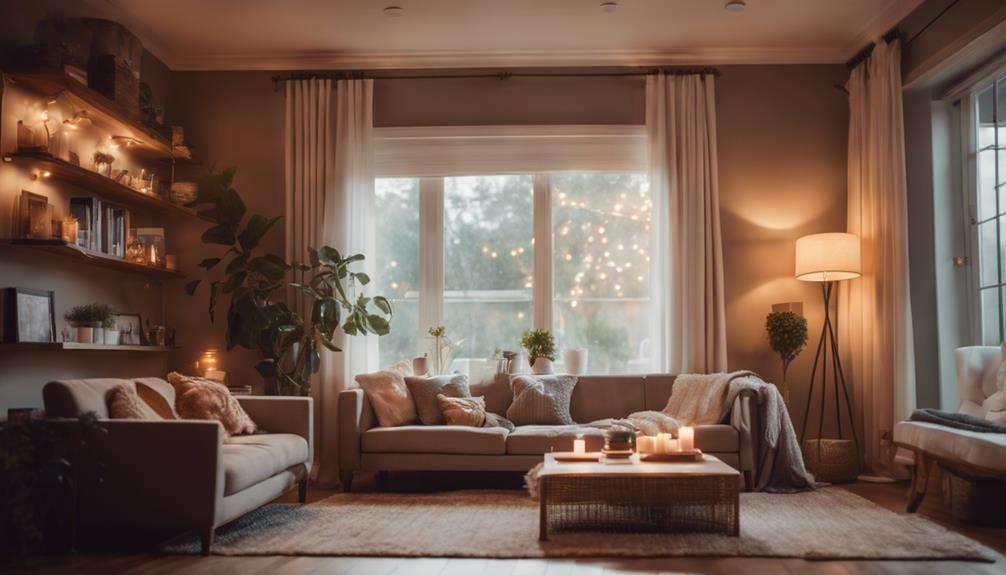
To achieve perfect lighting in any room, you need to understand the three layers of light: ambient, task, and accent.
Ambient lighting creates the overall atmosphere, while task lighting focuses on specific activities.
Accent lighting highlights unique features, bringing your space to life and making it feel complete.
Ambient Lighting Essentials
Creating the perfect ambiance in any room starts with understanding how to effectively layer ambient, task, and accent lighting.
Ambient lighting serves as the foundation, establishing the overall mood of your space. You can achieve this with overhead fixtures or by harnessing natural light sources. Think of it as the main source of illumination that fills the room, setting the tone for everything else.
When crafting your lighting plan, focus on maximizing the ambient lighting to create a warm and inviting atmosphere. This foundational layer should provide consistent brightness without harsh shadows, ensuring you can move comfortably throughout the space. Remember, the goal is to create a balanced environment that feels cohesive and pleasant.
To enhance the effect, consider the color temperature of your light bulbs. Warmer tones can evoke relaxation, while cooler tones may energize the room. By paying attention to these details, you'll create a welcoming ambiance that invites you to linger.
Once your ambient lighting is established, you can effectively incorporate task and accent lighting to elevate the overall aesthetic and functionality of your space.
Task and Accent Lighting
Incorporating task and accent lighting alongside ambient options enhances both the functionality and visual appeal of your space.
Task lighting is essential for illuminating specific areas where you perform activities like reading or cooking. By strategically placing it—such as under kitchen cabinets or at your desk—you can improve visibility, reduce eye strain, and boost productivity.
On the other hand, accent lighting highlights focal points in your room, such as artwork or unique architectural features. This type of lighting creates visual interest and elevates the overall aesthetic of your space.
When you combine ambient, task, and accent lighting, you create a well-balanced environment that caters to both functionality and mood. This layering not only adds depth and dimension but also allows you to adjust the atmosphere based on your needs. For instance, you can focus on task lighting during work hours and switch to softer accent lighting for relaxation in the evening.
Techniques for Layering Lighting

Layering lighting effectively transforms a room by combining ambient, task, and accent lighting to meet both functional and aesthetic needs.
Start with ambient lighting as your foundation. Use overhead fixtures or natural light sources to create a bright, inviting atmosphere. This overall brightness guarantees the space feels open and welcoming.
Next, strategically install task lighting in areas designated for specific activities. For example, place reading lamps near seating areas or add under-cabinet lights in kitchens. This enhances functionality, making it easier to complete tasks without straining your eyes.
Finally, incorporate accent lighting to highlight focal points like artwork or architectural features. Using wall sconces or spotlights can draw attention and add depth to your design. Don't forget to experiment with different fixture styles, such as pendant lights or floor lamps, to create visual interest.
To further customize your lighting, consider adding dimmers. This allows you to adjust the intensity, shifting the atmosphere from bright and energizing to soft and relaxing as needed.
Collaboration With Specialists

When you engage lighting experts, you tap into their knowledge to avoid common design pitfalls.
They provide effective solutions tailored to your space, ensuring your lighting enhances both mood and functionality.
Engaging Lighting Experts
Engaging lighting specialists can transform your space by crafting tailored plans that enhance both mood and functionality. By collaborating with these experts, you'll avoid common design mistakes and create an atmosphere that resonates with your personal style. They'll consider the unique architectural elements of your room, guaranteeing a cohesive approach to lighting design.
Here are some reasons why working with engaging experts is essential:
- Customized Solutions: They'll provide tailored advice that aligns with your vision.
- Innovative Designs: You'll benefit from creative ideas that incorporate various lighting types—ambient, task, and accent.
- Latest Trends: They've insights into smart lighting systems that offer energy efficiency and customizable ambiance.
- Refined Strategies: Expert feedback during the design process guarantees your chosen lighting fixtures promote relaxation and well-being.
Effective Design Solutions
Collaborating with lighting specialists guarantees you get effective design solutions that perfectly match your space's needs and style. These experts help you avoid common design mistakes, assuring your lighting illuminates the room while enhancing both functionality and aesthetics. They provide valuable insights into creating tailored lighting plans that align with the intended mood and purpose of each area.
By engaging with professionals, you can integrate lighting seamlessly with architectural elements, enhancing the overall design coherence. Specialists can recommend specific fixtures and technologies, like dimmers or smart lighting systems, to achieve the desired ambiance and flexibility. This tailored approach can transform a bland space into an inviting environment that reflects your personal style.
Utilizing feedback from lighting specialists refines your design strategies, promoting visually appealing and successful interior settings. Whether you're looking to create a cozy reading nook or a vibrant entertaining area, their expertise assures that every detail aligns with your vision.
Community Insights and Resources

Community discussions about lighting can reveal practical strategies that transform your space into a haven of comfort and style. By engaging with others, you'll discover how different lighting design techniques can enhance your mood and functionality. Sharing personal experiences can lead to valuable insights that improve your own lighting setups.
Here are some emotional takeaways from community insights:
- Feel the warmth of well-placed ambient lighting.
- Experience the joy of creating inviting spaces for loved ones.
- Discover how task lighting can boost productivity and focus.
- Unwind in a tranquil atmosphere with thoughtful lighting choices.
Room-Specific Lighting Solutions
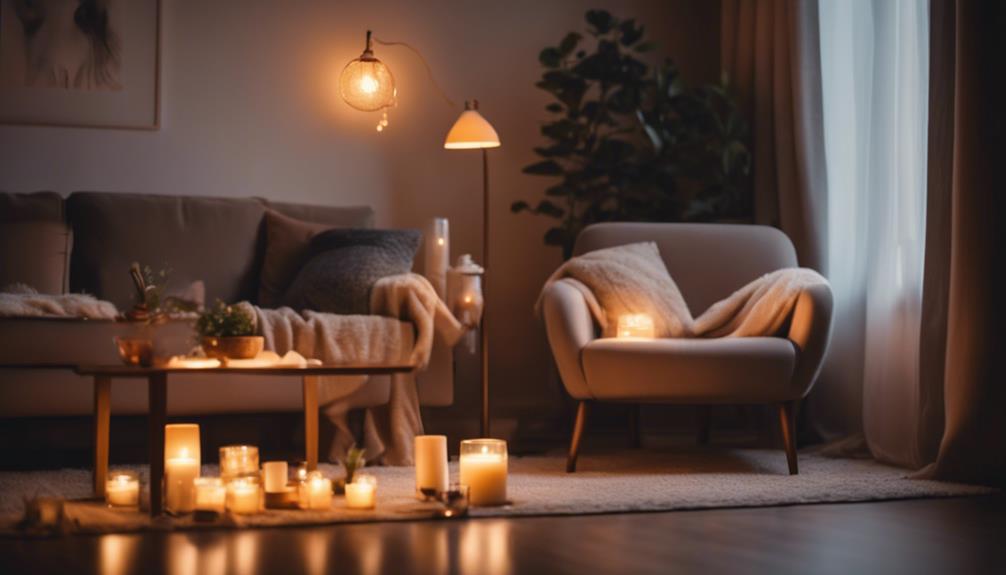
When it comes to lighting, each room has unique needs that can enhance its function and atmosphere.
In the bedroom, warm, layered lighting invites relaxation, while the kitchen demands bright, practical illumination for cooking tasks.
Bedroom Lighting Strategies
Create a cozy retreat in your bedroom by using warm, layered lighting that encourages relaxation and restful sleep. Incorporating a mix of light sources creates an inviting atmosphere, making it easier to wind down at the end of the day. Here are some strategies to evaluate:
Warm light: Opt for bulbs with temperatures between 2,000K and 3,500K to foster a calming environment.
Task lighting: Use bedside lamps for late-night reading or journaling, ensuring they provide ample light without being harsh.
Dimmable options: Install dimmers to adjust the brightness based on your activities, whether you're unwinding or preparing for sleep.
Multiple light sources: Combine wall sconces, table lamps, and overhead fixtures to avoid harsh shadows and create depth in your space.
Layering: Mix ambient, task, and accent lighting to enhance the overall aesthetic and mood.
Kitchen Illumination Essentials
Effective kitchen illumination blends ambient, task, and accent lighting to guarantee a safe and inviting cooking environment. You need bright lighting to assure safety and visibility while preparing meals. Overhead fixtures should provide even light throughout the space, eliminating shadows that can hinder your cooking efforts.
Consider adding pendant lights above your kitchen island not only for their aesthetic appeal but also for the additional practical illumination they provide.
Task lighting is essential in your kitchen. Under-cabinet lights are indispensable for illuminating work surfaces, making tasks like chopping and measuring much easier and more accurate. You'll find that the right task lighting dramatically enhances your efficiency.
Aim for a color temperature leaning towards bright white tones (3,500K-4,100K) to boost visibility and focus during cooking. This range helps you see colors accurately, which is crucial for food preparation.
Additionally, incorporating dimmable options allows you to adjust the mood, providing bright settings when you're cooking and softer lighting for casual dining experiences. With these strategies, you'll create a functional kitchen that's perfect for both cooking and entertaining.
Choosing Lighting for Mood

Choosing the right lighting can transform a room's atmosphere, helping you set the perfect mood for any occasion.
Start by evaluating each room's purpose and the vibe you want to create. Warmer light tones, typically found in soft light bulbs with a color temperature of 2,000K-3,500K, are fantastic for relaxation spaces, while cooler tones work better in areas where you need to stay alert.
Consider these tips to evoke the right emotions:
- Create a cozy ambiance for movie nights.
- Use brighter lights for energizing morning routines.
- Incorporate dimmers for adjustable intensity.
- Layer ambient, task, and accent lighting for balance.
Kitchen Design Trends

As you set the mood in your home, don't overlook the kitchen, where the latest design trends can elevate both style and functionality.
Minimalist designs are gaining traction, focusing on clean lines and clutter-free spaces, which not only enhance the aesthetics but also promote practicality. If you prefer a more relaxed vibe, consider a coastal theme that incorporates soft colors and natural materials, creating a soothing atmosphere reminiscent of the beach.
Farmhouse kitchens continue to charm with their blend of rustic elements and modern upgrades. Think open shelving and vintage-inspired fixtures that add character and warmth. To complement these styles, pendant lighting over your kitchen island serves as an effective way to combine practical illumination with a stylish focal point.
Don't forget the importance of natural light. Large windows or skylights can brighten your kitchen, making it feel airy and inviting. Combine this with strategic overhead lighting to guarantee your workspace is well-lit, especially during evening cooking sessions.
Specific Colors of Light

Specific colors of light can dramatically influence the mood and functionality of a room, enhancing both comfort and productivity.
By strategically selecting types of light, you can create an environment that resonates with your needs. Here's how different colors can impact your space:
- Blue hues: Boost cognitive performance and stimulate creativity.
- Green light: Promotes relaxation and supports better sleep quality.
- Red light: Reduces stimulation, perfect for winding down after a long day.
- Warm tones: Foster comfort, making spaces feel inviting and cozy.
When you choose the right colors, you're not just lighting a room; you're setting a mood.
Blue lighting, for instance, has been shown to accelerate post-stress recovery, while green light helps to soothe and calm.
By understanding the emotional responses tied to specific colors, you can tailor your lighting to suit various activities and atmospheres.
Scientific Studies on Light

Scientific research has uncovered how different types of light can greatly influence our mood, productivity, and overall well-being. For instance, exposure to blue light has been shown to enhance cognitive function and accelerate post-stress relaxation. This is essential for creating environments that promote focus and emotional stability.
| Type of Light | Effects on Mood | Impact on Productivity |
|---|---|---|
| Blue Light | Accelerates relaxation post-stress | Enhances cognitive function |
| White Light | Neutral mood enhancement | Standard productivity |
| Dynamic Lighting | Improves focus and engagement | Boosts learning environments |
Incorporating dynamic lighting systems can further improve spaces, especially in learning environments, by keeping students engaged. Additionally, melanopsin in our eyes responds to different light exposures, regulating our sleep and wakefulness. By understanding how light affects us, you can design your spaces for ideal mood and productivity. So, consider your lighting choices carefully; they can make a significant difference!
Frequently Asked Questions
What Is the Best Light to Set the Mood?
The best light to set the mood depends on the room. Use warm light for cozy spaces like bedrooms, and cool light for focused areas like offices. Layer different lighting types to create a balanced atmosphere.
What Lighting Is Best for Anxiety?
Imagine a cozy café at sunset; that warm glow eases your worries. For anxiety, opt for warmer color temperatures, soft ambient lighting, and natural light to create a calming atmosphere that truly nurtures your well-being.
What Is the Impact of Lighting on Mood?
Lighting considerably impacts your mood. Warm tones help you relax, while cooler tones keep you alert. Natural light boosts your emotional well-being, enhancing energy and sleep quality. Choose your light sources wisely for a better atmosphere.
What Is the Best Light for Mental Health?
Imagine sunlight dancing through your windows, lifting your spirits. For mental health, full-spectrum bulbs mimic this glow, while warm tones soothe you at night. Embrace light's embrace to nurture your mind and elevate your mood.
How Can Perfect Lighting Enhance the Aesthetic of Weird Room Decor?
Good lighting is crucial for highlighting the uniqueness of weird room decor ideas. The right lighting can bring out the colors, textures, and quirky elements, enhancing the overall aesthetic. With strategically placed lights, the weird room decor can truly shine and make a statement in any space.
Conclusion
Incorporating the perfect lighting can truly transform your space and elevate your mood.
Did you know that studies show well-lit environments can boost productivity by up to 20%? Imagine the difference it could make in your daily life!
By understanding the importance of layering light and choosing the right colors, you can create a welcoming atmosphere that not only enhances your home but also uplifts your spirit.
Don't underestimate the power of light—it's a game changer!


